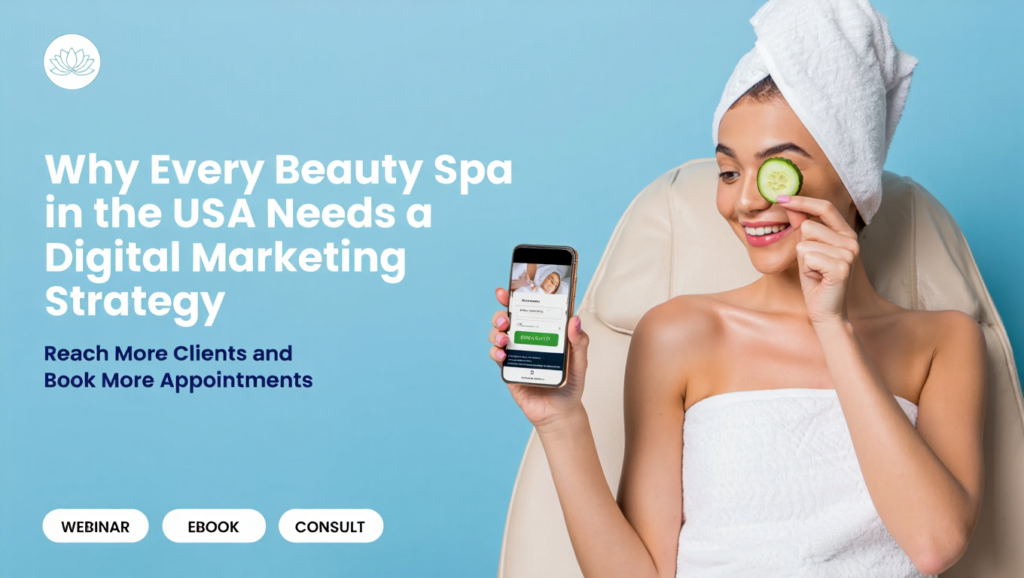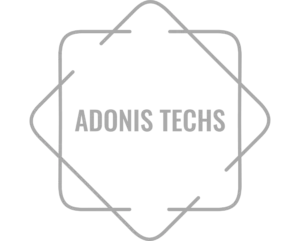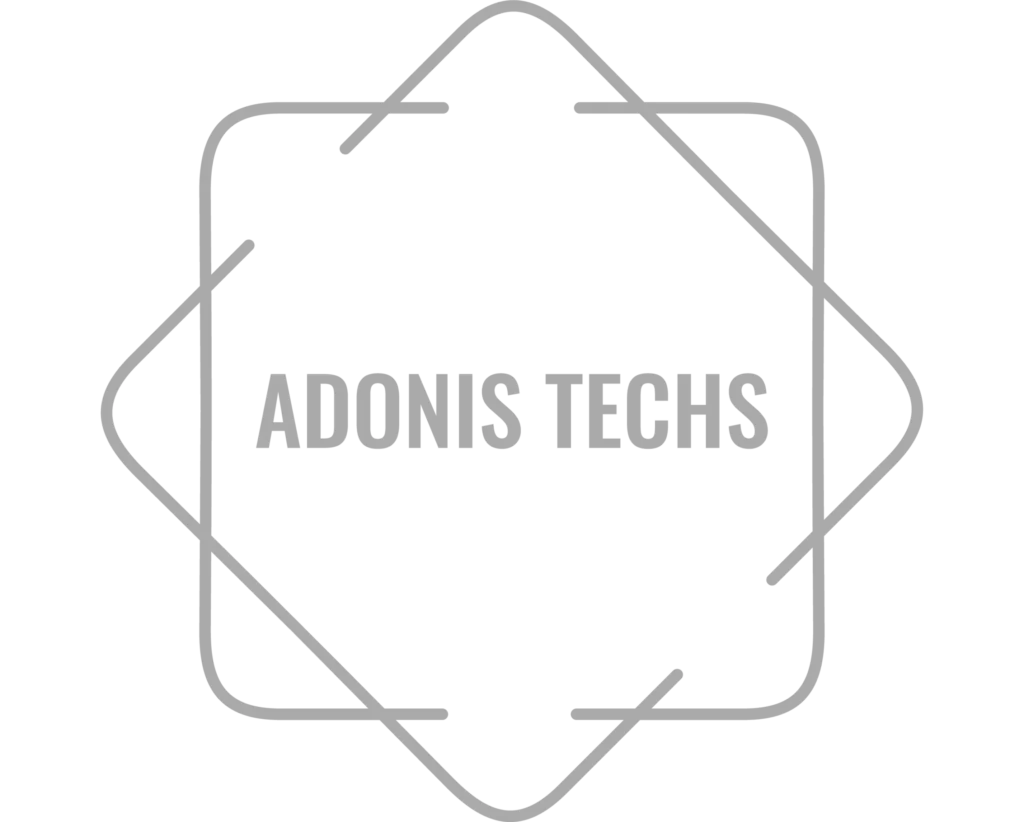
How the Spa Industry Is Evolving with Digital-First Clients
The spa and wellness industry in the USA has entered a new era, an era defined not just by quality treatments, but by how effectively businesses present themselves online. Today’s clients are digital-first. They turn to Google, Instagram, and TikTok before deciding which spa to book, and they expect seamless online experiences.
That’s why digital marketing for beauty spas USA is no longer optional it’s a necessity. Whether it’s ranking higher on search engines, using SEO for spas, or creating strong social media campaigns, a well-structured digital presence is the foundation of modern spa success.
Beauty spas that rely on outdated marketing are already losing ground to competitors who embrace strategies like skincare SEO, Instagram reels, and automated booking portals. Digital-first clients are younger, more tech-savvy, and more selective than ever before. They want to see reviews, before-and-after photos, and the convenience of booking online—all within a few clicks.
In fact, a recent industry analysis found that spas with strong spa marketing strategies and consistent online branding see 30–40% higher bookings compared to those still relying only on traditional methods. This is why, moving into 2025, spas must commit to beauty spa online growth with a clear digital roadmap.
Why Traditional Marketing Isn’t Enough
Not long ago, print ads, word-of-mouth referrals, and flyer campaigns were enough to keep spa appointment books full. But in 2025, those tactics barely scratch the surface of customer acquisition. Consumers are no longer browsing Yellow Pages or waiting for referral cards, they’re searching “spa near me” on Google and scrolling through Instagram before making decisions.
Here’s why traditional marketing alone is failing for spas:
- Decline of Print & Offline Channels
Magazines and newspapers no longer dominate consumer attention. Clients spend their time online, researching wellness tips, skincare products, and treatment reviews. Without digital marketing for beauty spas USA, businesses risk invisibility. - Limited Reach & Tracking
Flyers and billboards may grab some attention but lack measurable results. In contrast, modern spa marketing strategies using paid ads and SEO for spas allow precise targeting and real-time performance tracking. - Changing Consumer Behavior
Today’s spa clients want transparency before booking. They check reviews on Google, watch tutorials on TikTok, and compare services online. A spa without a strong digital presence won’t make the shortlist. - Competition with Digitally-Savvy Spas
Many spas already use Houston-based SEO experts to dominate local search rankings. Articles like Top 20 Marketing Agencies in Houston highlight just how competitive the space has become. Without digital adoption, traditional-only spas risk losing their customer base to tech-driven competitors.
For example, a local spa investing in the best SEO services in Houston can appear at the very top of Google searches like “spa near me” or “best facial in Houston.” Meanwhile, a competitor relying only on word-of-mouth may not even appear on page one.
This shift underscores the urgent need for beauty spas to embrace digital transformation, a theme echoed across industries in resources like Business Digitalization and Transformation Strategies. For spas, digital marketing isn’t a nice-to-have, it’s survival.
SEO for Beauty Spas – Ranking for “Spa Near Me” and Service Pages
Search engine optimization (SEO) is the foundation of beauty spa online growth. When clients search phrases like “spa near me,” “facial treatments in Houston,” or “best massage for stress relief,” they’re signaling purchase intent. The spas that appear in those top results are the ones capturing the majority of new bookings.
Here’s how SEO for spas works in practice:
- Keyword Research
Identifying the right keywords is crucial. A blend of local terms (e.g., “spa in Houston,” “day spa near me”) and service-specific keywords (e.g., “microdermabrasion Houston,” “deep tissue massage Dallas”) ensures visibility. Tools like SEMrush and Ahrefs can uncover high-volume terms, but working with specialists such as a Houston SEO company makes the process far more precise. - On-Page SEO
Each service page should include optimized titles, meta descriptions, and structured content. For example, a facial treatment page should include detailed descriptions, benefits, FAQs, and pricing options, all optimized for skincare SEO. - Local SEO
Creating and optimizing a Google Business Profile is non-negotiable. Reviews, photos, Q&A, and accurate location details help spas rank higher in Google Maps results. In fact, well-optimized local listings often outperform traditional ads for “near me” searches. - Backlinks & Authority
Earning backlinks from local directories, wellness blogs, and industry sites builds credibility. Articles like SEO Strategies for Skincare Brands in the USA show how beauty businesses can leverage partnerships and guest posting for long-term SEO benefits.
Spas that consistently apply these tactics don’t just get clicks, they secure steady new bookings. SEO is an investment that compounds, unlike paid ads which stop working once the budget runs out.
Social Media Power for Spas – Instagram, TikTok, and Influencer Collaborations
If SEO is about visibility, social media is about connection. Beauty and wellness are visually-driven industries, making platforms like Instagram, TikTok, and YouTube ideal for showcasing spa experiences. For spas aiming for digital marketing for beauty spas USA, this is where branding and storytelling happen.
- Instagram Reels & TikTok Tutorials
Short-form video is the king of content. Behind-the-scenes clips of facial treatments, massage setups, or skincare product demos can generate thousands of views. Spas that highlight real transformations often go viral, boosting trust and brand recall. - Influencer Marketing
Partnering with beauty influencers, whether micro-influencers with local followings or national wellness advocates, brings credibility. For spas, local influencer collaborations often drive the highest ROI because they reach audiences who can actually visit in person. This is the same strategy discussed in Social Media Marketing for Beauty Brands in the USA. - User-Generated Content (UGC)
Encouraging clients to share their experiences online is a powerful form of social proof. Simple incentives like discounts on their next service in exchange for a tagged post can spark organic exposure. - Cross-Platform Consistency
Each platform has its strengths. Pinterest is excellent for long-form guides and infographics, Instagram for visuals, TikTok for quick engagement, and YouTube for tutorials. Spas that tailor content across platforms see stronger results.
With social media, consistency is key. Posting once a week isn’t enough; a structured calendar aligned with seasonal promotions, beauty trends, and treatment launches is necessary for beauty spa online growth.
Paid Ads That Drive Bookings – Google Ads & Meta Ads
While SEO builds long-term visibility, paid ads give beauty spas the power to instantly reach potential clients who are actively searching for services. With platforms like Google Ads and Meta Ads (Facebook & Instagram), spas can attract new clients with highly targeted campaigns.
- Google Search Ads
When someone types “best spa near me” or “facial treatment in Houston,” a well-optimized Google Ad ensures your spa shows up at the top of search results. Unlike print flyers or radio ads, you only pay when someone clicks, making it highly cost-effective. - Meta Ads (Facebook & Instagram)
These platforms allow spas to run visual campaigns showcasing calming spa interiors, treatment benefits, or limited-time offers. Targeting options like age, location, and interests (e.g., skincare, self-care, wellness) make it possible to reach the exact audience likely to book a session. - Remarketing Campaigns
Ever visited a spa website and later seen their ad again on Facebook? That’s remarketing. For spas, this is an excellent way to bring back visitors who didn’t book during their first visit to the website. - Local Campaigns
Platforms now offer location-based targeting. For example, a spa in Dallas could run ads that only show up for people within a 10-mile radius. This ensures ad spend is maximized where it matters most.
As discussed in How Digital Marketing is Transforming Weight Loss Businesses, paid campaigns allow wellness-focused businesses to scale quickly. For spas, the combination of immediate visibility and precision targeting can lead to fully booked appointment calendars.
Content Marketing for Trust – Blogs, FAQs, and Self-Care Guides
In the beauty and wellness industry, trust is everything. Clients need reassurance that treatments are safe, beneficial, and worth the investment. That’s where content marketing comes in. By creating high-value educational content, spas can build credibility and nurture long-term client relationships.
- Blogging About Treatments
Blogs can explain the science behind treatments like microdermabrasion, facials, or massage therapy. A well-written post not only answers client questions but also boosts SEO rankings by targeting specific service keywords. - FAQ Pages
An FAQ section on the website helps address common concerns such as “How often should I get a facial?” or “Is microdermabrasion safe for sensitive skin?” These pages build confidence and reduce barriers to booking. - Self-Care Guides
Wellness isn’t limited to spa visits. Sharing home-care tips, skincare routines, or relaxation techniques positions the spa as a trusted resource. It also encourages repeat visits when clients want professional treatments beyond at-home care. - Video Content
Tutorials, expert interviews, or behind-the-scenes looks at spa services can be repurposed across blogs, YouTube, and social media. This type of content strengthens authority while humanizing the brand.
For inspiration, look at strategies used in Digital Marketing for Beauty Product Businesses in the USA, where content builds brand authority and trust with the audience. Spas can adopt the same principles to establish themselves as leaders in self-care and beauty wellness.
Online Reputation Management – Reviews, Testimonials, and Social Proof
In the spa industry, reputation is currency. A single negative review can deter dozens of potential clients, while glowing testimonials can help fill appointment slots for months. That’s why managing your online reputation is a non-negotiable part of digital marketing for beauty spas.
- Google Reviews & Local SEO
When people search “spa near me,” reviews on Google Business Profile play a huge role in which businesses they trust. Spas with a consistent stream of 4.5+ star reviews not only look credible but also rank higher on local search results. - Showcasing Testimonials on Your Website
Embedding client testimonials directly on spa service pages adds instant credibility. Instead of just claiming you provide relaxing massages or rejuvenating facials, let your happy clients do the talking. - Social Proof on Social Media
Posting client success stories, before-and-after images (with permission), and influencer shoutouts builds trust quickly. This method is already driving growth for beauty brands leveraging social media marketing strategies to enhance visibility. - Proactive Reputation Monitoring
Tools like Google Alerts or specialized review management software help spas monitor mentions across the web. This allows quick responses to negative comments and ensures your brand image remains strong.
Much like in the SEO for Healthcare Businesses in the USA space, where credibility directly impacts patient acquisition, spas must actively cultivate and protect their reputation to attract a steady stream of new and repeat clients.
Building Customer Loyalty Online – Email Marketing, Referral Discounts, Memberships
Acquiring new clients is important, but loyalty is where profits multiply. Returning clients tend to spend more, refer friends, and become brand advocates. Digital strategies make it easier than ever to retain spa clients through personalized engagement.
- Email Marketing Campaigns
Weekly or monthly newsletters can share treatment tips, seasonal offers, or spa updates. Advanced segmentation allows spas to send targeted emails, for example, reminding a facial client when it’s time for their next session. - Referral Discounts
Clients trust recommendations from friends more than ads. Offering a referral program, like “Bring a friend and both get 20% off”, encourages word-of-mouth marketing while rewarding loyal customers. - Membership & Loyalty Programs
Many modern spas are now offering subscription-style memberships (e.g., a monthly massage package). This creates predictable revenue while giving clients a reason to return regularly. - Personalized Offers & Retargeting
Using simple CRM tools, spas can track client preferences and send tailored offers (e.g., birthday discounts, skincare product bundles). When combined with retargeting ads, this strengthens client relationships and encourages repeat bookings.
As highlighted in Business Digitalization Transformation Strategies, loyalty programs and client engagement systems not only retain customers but also future-proof businesses against rising competition.
Tracking Digital Success – Appointments, Lead Forms, Conversions
Digital marketing for beauty spas in the USA isn’t just about visibility, it’s about measurable growth. Without tracking and analytics, spas risk spending on campaigns without knowing what works. That’s where performance monitoring becomes essential.
- Website Analytics
Tools like Google Analytics and GA4 reveal which services pages (e.g., facials, massages, skin treatments) generate the most traffic and conversions. This allows spa owners to double down on high-performing content. - Booking System Metrics
Online booking platforms integrated with websites give clear insights into the number of appointments generated directly from SEO or ad campaigns. This is one of the clearest ways to measure ROI. - Lead Form Tracking
Spas often use forms for inquiries, gift card purchases, or consultation requests. Monitoring the conversion rate of these forms provides actionable insights into what messaging resonates best with potential clients. - Call Tracking
Many clients prefer to call rather than book online. Dynamic call tracking can attribute phone bookings to specific campaigns, whether they came from local SEO, paid ads, or organic blog content. - Customer Lifetime Value (CLV)
Instead of focusing only on one-time bookings, spas should measure CLV, the total revenue a client generates over time. This metric justifies investments in long-term loyalty programs and retention strategies.
In fact, the way top SEO agencies in Houston measure ROI for beauty and healthcare clients is through these same performance-driven KPIs. By tracking conversions at every stage, spas can scale intelligently instead of blindly spending.
Conclusion + Call-to-Action – Why Spas Should Partner with AdonisTechs
The spa industry is no longer just about luxury treatments, it’s about delivering digital-first experiences to meet the expectations of modern clients. From SEO for spas and social media growth to online reputation management and loyalty-driven retention campaigns, digital marketing is the backbone of beauty spa online growth in 2025 and beyond.
Here’s a quick recap of why every beauty spa in the USA needs a digital marketing strategy:
- SEO puts your spa on the map (literally, for “spa near me” searches).
- Social media creates visibility and trust through engaging content.
- Paid ads drive instant bookings while organic SEO builds long-term credibility.
- Content marketing builds authority by educating clients and showcasing expertise.
- Reputation management secures credibility with reviews and testimonials.
- Loyalty programs and email campaigns keep clients coming back.
- Performance tracking ensures marketing dollars generate measurable ROI.
At AdonisTechs, we specialize in empowering spas and wellness businesses with tailored digital solutions, from skincare SEO and web development in Houston to healthcare transformation portals and comprehensive digital marketing strategies.
👉 If you’re ready to scale your spa with industry-leading SEO, social media, and digital growth strategies, partner with AdonisTechs today and stay ahead of the competition.


